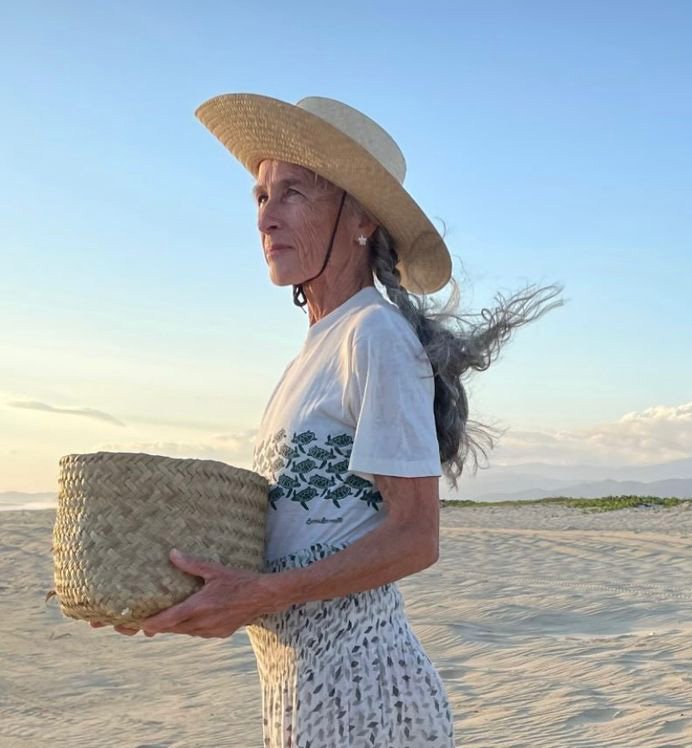Georgita Ruiz
This post is part of our Living Legends series that spotlights key people in sea turtle conservation.
Biography
Georgita trained as a veterinarian in Mexico before serving in numerous roles as a researcher, conservationist, and advocate for her country’s sea turtles on both the Pacific and Gulf coasts. She did temperature-dependent sex determination research, studied incidental capture of loggerheads in Baja California, and became deeply engaged in halting the massive sea turtle exploitation at the now infamous slaughterhouse in Mazunte (Oaxaca), which is adjacent to the largest arribada nesting site on Earth at Escobilla beach and is where hundreds of thousands of ridleys were killed from the 1960s to the 1980s. She set her mind on stopping what became known as the “Shame of Escobilla,” and she was a major voice in the movement that led to the Mexican government’s complete ban of sea turtle commercialization in 1990. Georgita worked on the binational Kemp’s ridley recovery program at Rancho Nuevo; she started leatherback and olive ridley protection camps in Oaxaca; and she led projects in Veracruz, Quintana Roo, and elsewhere in Mexico. Georgita’s global reputation as an outspoken sea turtle activist led to her appointment as a federal environmental law enforcement delegate in Oaxaca, a role that she held for nearly a decade. During her tenure, she showed incomparable bravery in the field alongside federal police and the Mexican army. One case resulted in the tracking-down and confiscation of an illegal shipment of more than half a million sea turtle eggs destined for market, the arrest of smugglers, and the seizure of a 10-ton truck. This case made headlines internationally and sent a powerful message to future would-be offenders. She later became general director of wildlife and head of the priority species program for Mexico’s Commission for Protected Areas. Recently, she cofounded a nonprofit that is dedicated to the conservation of birds and sea turtles.
What was your first sea turtle moment?
As a veterinary student in 1977, I volunteered to work with olive ridleys at the famous arribada beach at Escobilla in Oaxaca. We arrived at midnight to the warmth, the sweet smell of tropical vegetation, and the sound of waves crashing. After trudging through mosquito-infested mangroves, we arrived at a long beach illuminated by a full moon, covered with little black hatchlings marching to the sea like wind-up toys! It was the most spectacular manifestation of life I had ever seen.
What is your proudest accomplishment?
My proudest accomplishment was being one voice in the 13-year-long movement that ultimately resulted in Mexico’s total ban on sea turtle exploitation in May 1990, alongside sea turtle luminaries such as Archie Carr, Peter Pritchard, Jack Woody, and Karen Bjorndal; countless Mexican students; nonprofits such as Pronatura, Bioconservación, Green Peace, and Earth Island Institute; and government officials, attorneys, businessmen, poets such as Homero Aridjiz, community activists, and more.
What is different now from when you started?
Mexico’s sea turtle business killed tens of thousands of turtles and exported products from the late 1960s until the ban. Today the slaughterhouse is gone, and people have embraced the truth that sea turtles are worth more alive than dead. It is heartening to see the participation of so many local communities in sea turtle conservation. One family I know, which once supplied turtle eggs to the black market, made an about-face to become a sea turtle conservation cooperative called Vive Mar, on an important leatherback beach, where family members are now doing turtle conservation instead. The Grupo Tortuguero in the Baja Peninsula is another excellent example of community involvement in sea turtle conservation that is now spreading to fishers and their families in other Mexican states.
Also, many of Mexico’s sea turtle populations are recovering. The Kemp’s ridley has shown increasing numbers and an expanding range, thanks to the ongoing binational conservation efforts that go back to 1968. The olive ridley is also increasing on the Pacific coast, as is the green (locally called “black”) turtle in Michoacán. But all is not good news, because the Pacific leatherback is still in trouble; at the beach in Chacahua National Park, for instance, nest numbers dropped from 3,500 (1982–1983) to a mere 150 (1985); now we are lucky to see a maximum of 40 nests annually.
What are you most hopeful (and worried) about?
I am hopeful to see more communities working to conserve beach and ocean habitats more carefully. But I am worried about the many young Pacific loggerheads that migrate from nesting beaches in Japan to feed offshore in the Baja Peninsula, where incidental capture is still a severe threat. I am also worried about the Pacific hawksbills that appear to be dwindling without any specific conservation measures being implemented. And, of course, I worry about the eastern Pacific leatherbacks throughout their range.
What is your advice to people new to this field?
Nothing is impossible. My working for 13 years to achieve the ban in Mexico, a country led by a one-party dictatorship for more than 80 years, seemed like a crazy fantasy. But a ban had to occur, so we remained steadfast in our campaign. When it actually happened, the ban was an unbelievable surprise.
We should never give up. As Rudyard Kipling states in his poem “If”: “Rest if you must, but don’t quit.”
Alliances are VERY powerful. Encouraging people to come together toward an honorable goal that will bring good things to the community and to future generations, as well as getting them to accept that the goal is more important than any of the individuals involved, is an incredibly important and effective way to leverage positive change.
An ounce of prevention is worth a pound of cure. Regard the costs involved in bringing a species back from near extinction compared with the costs of having prevented it from happening while the populations are still strong.
Practice honesty and dignity—always.

